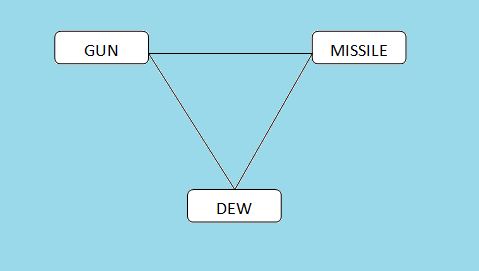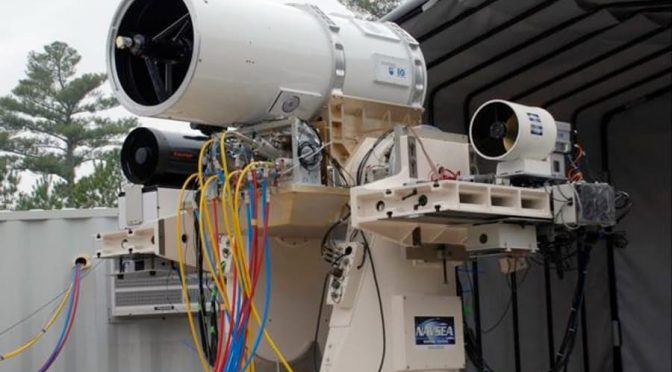By Paul Bragulla
To date, the story of laser weapons has been one of great promise but slow delivery. However, modern developments in the fields of materials science, optics, and computer technology are making it increasingly likely that they will reach operational status in the next decade. This realization has prompted laser weapon-development programs around the world, including Germany and China.
Progress in the development of solid state lasers (SSLs) has been especially rapid. In January 2013, Rheinmetall – a German corporation – demonstrated a 50 kW prototype capable of anti-drone and counter-rocket, artillery, and mortar (C-RAM) functions. Rheinmetall also has plans for a technology demonstrator in the 60 kW range next year and has indicated they believe there are no major technical barriers to the construction of a 100 kW device1. According to a Congressional Research Service report, 100 kW is the beginning power range at which a laser becomes an effective C-RAM battery, or can defeat subsonic anti-ship cruise missiles (ASCMs) and manned aircraft2.
Due to the great power, cooling, and volume capacity of surface warships it has been suggested that, of all the services, the U.S. Navy is the ideal “first adopter” of high-energy laser weapons in the 100+ kW range3. This implies that early laser weapons of other nations may also see their first operational use on warships. Additionally, fitting lasers to warships may counteract the offensive-defensive imbalance that has developed in the last 50 years whereby the cost of anti-ship weapons has declined while the cost of their respective countermeasures has remained high. A laser pulse capable of disabling an ASCM may cost a few dollars in comparison to the $800,000 price of a Rolling Airframe Missile (RAM). Laser weapons are also touted as simplifying logistical requirements and allowing longer time on station, as they do not require ammunition reloads.4
There has been abundant analysis of the technical characteristics of various potential laser weapon systems and their possible effects on various targets, although much more must be done before these systems can take their place alongside proven technologies. Here, however, I would like to focus on the larger-scale impact laser weapons may exert on the development of naval warfare in the 21st century. How will they affect the balance of measure and countermeasure? How might state and non-state actors respond to the development of weapons which render unfavorable the currently favorable (to them) cost-benefit ratio of their anti-ship weapons to our defenses?
I must make many assumptions, but I will do my best to ensure that these are both explicit and reasonable. My first general assumption is that within the next decade, SSLs with beam powers of up to 500 kW will be developed5. Such lasers would be able to engage UAVs, subsonic ASCMs, artillery rockets and shells, and manned aircraft. It has been estimated that the Flight III Arleigh Burke-class guided missile destroyers (DDGs) will have the excess power and cooling capacity to support up to a 200 kW SSL , which would be capable of all of the above with the exception of engaging manned aircraft.

The possibility exists of outfitting other ship classes, such as the Gerald R. Ford-class aircraft carriers and Zumwalt-class DDGs, with greater power-requirement weapons and the Navy has expressed an interest in equipping them with free-electron lasers (FELs). I assume that FELs with up to 1 MW of beam power will prove practicable within 20 years. Compared to SSLs, installing these brings far larger weight as well as radiation shielding considerations and so are likely to be fitted to specialized laser-ships, possibly select Zumwalts built with the air/missile defense role in mind. Alternatively, SSL technology may advance in ways that make multiple SSLs firing together more economical than fewer, larger FELs.
What follows from these assumptions? First, it is very unlikely that laser weapons will largely replace missiles or guns in the world’s naval arsenal. Instead they will add more arrows, with unique advantages and limitations, to the naval commander’s quiver. There are some things, like C-RAM and anti-UAV, which are within the capabilities of even the relatively lower power lasers that can be mounted on the Flight III Arleigh Burkes. The advantages of such a laser-based Close-In Weapon System (CIWS) are magnified by the fact that an opportunistic attack by means of rockets, artillery, or mortars against an American ship in a foreign port or naval choke point – whether by state or non-state actor – is a far likelier near-term danger than an attack on the high-seas by supersonic ASCMs. Compared to an expensive interceptor missile or collateral-damage-causing gun-based CIWS, the superiority of using a few dollars’ worth of electrical power to destroy an incoming threat is apparent. Such a system adds another layer to warship armaments, freeing missiles and guns to concentrate on targets more suited to their particular capabilities.
However, to fully appreciate the implications of this technology we must build a conceptual framework that integrates lasers with extant weapons systems. The two primary types of weapons systems currently available to the world’s navies are guns and missiles. The distinguishing features of gun-type weapons systems are that they employ an unguided projectile which lacks an on-board propulsion system, while those of missile-based systems are that they use a guided projectile which is propelled to the target by an on-board propulsion system. Like all weapons, both seek to disrupt the functions of a target by depositing energy within it.

If we consider these two types further we see that they can be viewed as points along a spectrum, upon which there are many possibilities. For instance, rocket-assisted artillery shells and guided artillery shells have characteristics of both guns and missiles; they mix the advantages and limitations of the two extremes.
The advent of lasers and other Directed-Energy Weapons (DEW) adds a third vertex to our diagram, and expands the spectrum of possibilities into a two-dimensional field.

Lasers excel at destroying lightly-armored targets which move or maneuver rapidly within line of sight (LOS) of the weapon. Thus, they complement rather than replace the other two approaches. Missiles and guns are better used to engage non-LOS targets, which may be slower moving and more heavily protected, or under meteorological conditions unfavorable to lasers.
Another use of this diagram is to explore the possibilities for new weapons systems that may or may not currently exist. Weapons along the gun-missile edge have been identified, but what of the other two? Are there possible weapons which combine aspects of all three vertices, and so fall in the space between the edges? Boeing’s new Counter-electronics High-powered Microwave Advanced Missile (CHAMP)6 is a cruise missile that carries a microwave DEW capable of disabling electronics near its flight path, and so would seem to occupy a spot along the Missile-DEW edge. This space is also shared by various “bomb-pumped” DEW concepts that use the energy of a nuclear initiation to excite an X-ray lasing medium, as in Project Excalibur, or generate a plasma jet like the “casaba howitzer” developed through Project Orion.
The introduction of powerful laser weapons will likely cause a tumult in weapons development as both the particular abilities of various laser configurations are tested and countermeasures developed. In addition to armoring conventional missile designs, is there the possibility of developing a new type of gun-missile hybrid to exploit the particular weaknesses of laser weapons? An ASCM variant which, from beyond LOS, launches one or more solid depleted uranium or tungsten penetrator darts at high-supersonic velocity towards a target ship might fit this role. Such a penetrator would be more difficult for a laser to deflect or destroy than any missile, though a conventional interceptor might find it less challenging.
In following segments, I will explore more aspects of the possible development of laser weapons and their countermeasures. What scenarios emerge from a future in which high-energy FELs advance faster, or slower, than expected? What strategies, technological and otherwise, might various potential opponents of the U.S. Navy take to counter such weapons? What does a scenario in which MW-range laser weapons and railguns advance rapidly mean for the future of missiles and aero-naval warfare as a whole? We cannot know what is to come until we experience it, but with careful forethought we may prepare the conceptual foundation for rapid and effective responses to future challenges.
Paul W. Bragulla is the recent cofounder of Prokalkeo, an emerging technology consulting company headquartered in the Washington, D.C. area. He holds a BS in Physics from Rensselaer Polytechnic Institute and is an enthusiastic scholar of military affairs. His scientific experience is primarily in the fields of high-energy lasers and aerospace technology.
1. Peter Murray, German Military Laser Destroys Targets Over 1Km Away.
2. Ronald O’Rourke collects the results of several studies on laser effectiveness into a single table in Navy Shipboard Lasers for Surface, Air, and Missile Defense: Background and Issues for Congress (Congressional Research Service, 2013), table A-1, 36.
3. Mark Gunziger and Chris Dougherty specifically suggest high energy SSLs as the technology of interest in their Changing the Game: The Promise of Directed Energy Weapons (Center for Strategic and Budgetary Assessments, 2012), but point out that the Navy is also strongly focused on Free-Electron Lasers (FELs) which promise multi-megawatt outputs suitable for the Anti-Ballistic Missile (ABM) role as well as the ability to tailor the frequency of their output to local meteorological conditions.
4. The notable exceptions to this rule are chemical lasers, which utilize the energy of a chemical reaction to generate their beams. They are also the only lasers currently capable of producing megawatt-range outputs.
5. Changing the Game: The Promise of Directed Energy Weapons, 25.
6. Randy Jackson, CHAMP – Lights Out.
Featured Image: Laser weapon prototype (U.S. Navy)


I hope you don’t mind if I pen an article along your line of inspiration for the blog as well. A friend at DELEX and I have been talking about just this, and the real kicker seems to be energy consumption and weather. Embracing lasers could make weather/seasons even more important than ever before. Something as simple as fog could eliminate a groups potentially most effective defenses. Also, if you’re being swarmed, power drain may make only nuclear power appropriate. It might also encourage the navy to push past their typical 15% power operating level on ship-born reactors. Have you considered any potential use for OTH strikes, as well?